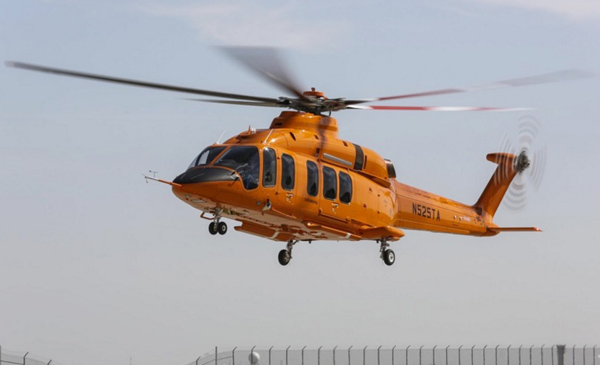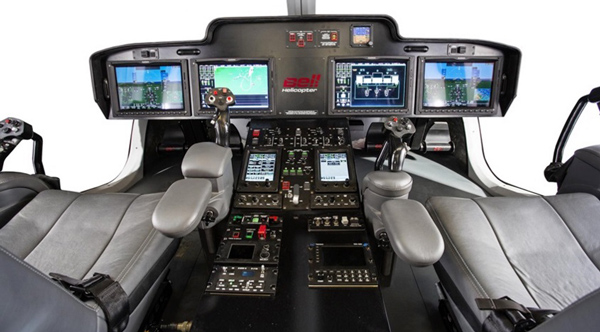Podcast: Play in new window | Download
Subscribe: RSS

Our guest today is Larry Thimmesch, Vice President Bell 525 Relentless Sales. Larry has been involved with the 525 for the last 5 years from the program’s very earliest days.
The 525 is Bell Helicopter’s largest helicopter to date and weighs in at 20,000lbs or 9000kg. It has been created off a completely clean sheet design and will be the world’s first commercial fly-by-wire helicopter. In this interview you’ll get to hear about the background to the design process and a run down of the technology and advances built into a whole range of the aircraft’s systems.
When Larry first started at Bell Helicopter as the VP of Commercial Programs there was a goal of growing the commercial side of the company in the face of decreasing defence budgets.
From the outset the program aimed to incorporate capabilities developed from recent Bell Helicopter military design experience and to include the best of current technologies avaliable.
A review of the most common causes of rotorcraft accidents was undertaken with a focus on identifying where technology could add value and safety – whether that was Bell internal technology or what was currently in the marketplace.
[Tweet “Fly-by-wire design – 3 completely independent electrical, hydraulic and actuation systems #bell525”]

A customer working group were invited into the design process and came up with a Christmas shopping list of features they wanted which included a <20,000lbs MTOW, more baggage volume, safety and a non-negotiable CAT A performance along with many more key requirements. 6 months later the Bell 525 program team were able to show this same customer group a full scale wooden mockup of the design.
With 10,000 all new designed parts, the Bell 525 Relentless is a helicopter that they are planning to last in the market for the next 10, 20 even 30 year period.
At the time of recording Flight Test Vehicle 2 (FTV2) is being shown at HeliExpo 2016 with a third aircraft to join the certification phase shortly.
[Tweet “Aircraft maintenance data can be passed via satellite connection back to base engineers while in flight. #bell525”]
Podcast: Subscribe in iTunes | Play in new window | Download
In this week’s episode:
01:45 HeliExpo 2016
02:15 Larry Thimmesch – Boeing, Bombardier, Bell Helicopters
05:20 Customer advisory panel 2011 – 85 different kits/layouts
08:00 Developing the value proposition and getting the message out
09:30 Coming up with the name and model number
11:10 Expected roles and industries
14:00 Clean sheet design – how you do that
18:25 Full scale wood mockup of the aircraft 6 months later
21:00 Size of the program staff – up to 500 people at peak – and cross specialty input
25:10 Early performance figures – range, loads, Vne
27:36 Engine powerpack and rationale
30:00 APU – customer design request to have cabin cooling without blades turning
31:10 Triple redundancy, voting fault tolerance, integrated maintenance recording system and fleet wide data
35:50 Cockpit design and IR field ‘touch’ screens
39:10 Philosophy for fly-by-wire control approach
41:50 Cat A departure engine failure self recovery by autopilot
43:33 Canted tailrotor design – hover attitude and CoG envelope
45:20 Flight controls/joysticks with force feedback
47:10 MFD / PFD layout and presentation
50:10 5 bladed rotor disc – large diameter to achieve Cat A performance
52:00 Gearboxes – 7 transmissions total, engine RPM is stepped down before main transmission, specialized materials
55:00 Lift assist tailboom patented design – extra 400lbs of hover capability
57:55 Crashworthiness and egress features
1:03:30 Maintenance and support planning
1:05:45 Training approach, simulators, courses
1:08:10 Standing up a capability from day one with operator
1:11:40 Future milestones over next few months and certification
1:18:15 Episode Sponsors trainmorepilots.com – LinkedIn tip about vanity URLs
Links from this week’s episode:
Bell Helicopter website for the 525 Relentless
Larry Thimmesch on LinkedIn
[Video] – Flight Test Vehicle 1 flying shots.
[leadplayer_vid id=”56D42577709A4″]
The #Bell525 FTV1 is taking on cold weather performance testing in temperatures as low as -14°F in Alamosa, CO. pic.twitter.com/3S1AV1YhyG
— Bell Helicopter (@one_bell) February 3, 2016
[Tweet “It takes a while to design an aircraft from nothing. We have 10,000 parts on this aircraft & they are all brand new. It is a daunting task. #bell525”]

Do you have a question about the Bell 525 or have a comment about the episode? Be part of the conversation below.

Thanks Mick. How is the 525 program progressing? Are Bell’s key competitors already ahead in this segment of the market? News from the HeliExpo was 42ish airframes initially. That flight deck looks pretty awesome! http://www.bellhelicopter.com/commercial/bell-525
Hey Bug! Thanks for dropping a comment. Yeah it looks a pretty sweet machine. I’ve seen mention that they are getting over 200kts in flight tests and have increased the passenger seating from 16 to 18. As Larry points out, not the best time in history to be launching but hopefully the market picks up not too far in the future.
Mick question that you might be able to relay to the Bell team. Unfortunately a 525 and it’s crew of two test pilots was lost in 2016. My simple understanding of it is that feedback loop oscillations grew in the collective control system and caused a low Nr condition which led to the loss of aircraft.
I understand Bell had safeguards in place for the cyclic controls and is now taking some great measures to correct the collectives issues. My question is what about the anti-torque pedals? I’ve attached a link to article below that talks about the event in greater detail. Thanks!
http://www.rotorandwing.com/2018/01/17/ntsb-approves-probable-cause-fatal-bell-helicopter-525-crash/#.WmAURmJMGEc